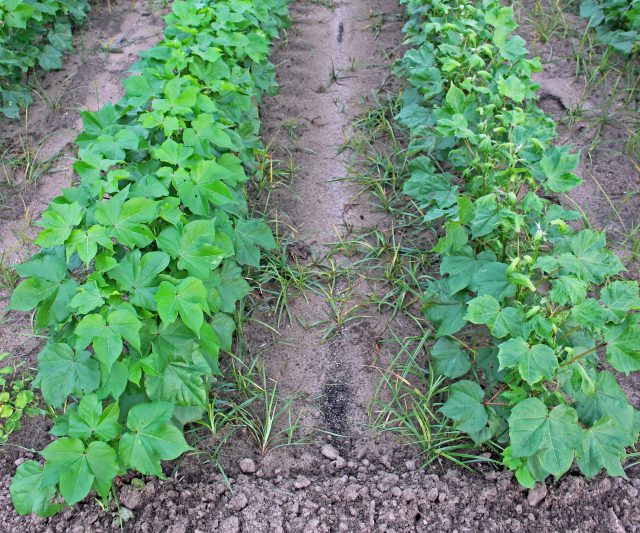The past two months have been life altering for many farmers in the southeast, especially the Florida Panhandle. Hurricane Michael made landfall in the Panhandle on October 10th and left a path of destruction spanning several counties as it continued into Southwest Georgia. With the aftermath of Michael, farmers from Walton to Gadsden counties were left without power and severe damage to crops and equipment.
On October 31st, the Environmental Protection Agency (EPA) announced that it was extending the registration of Dicamba for over-the-top (OTT) use for weed control in transgenic cotton and soybean. Dicamba products approved for use on dicamba-tolerant crops include Engenia (BASF), XtendiMax (Monsanto), and FeXapan (Corteva). This announcement came during a period when much of Jackson and Calhoun Counties, a large cotton producing area, wwere without power. The purpose of this article is to help promote the announcement and raise awareness regarding label changes for products approved for use in Dicamba-tolerant cotton and soybean. Another product to follow is chlorpyrifos, better known as Lorsban, which, depending on outcomes of legal/regulatory proceedings, will likely still be available for use during the 2019 season.
Dicamba
Along with the EPA announcement of the two-year extension in registration of dicamba products used in row crops (now through 2020), new restrictions were revealed that will be integrated into product labels. It is imperative that growers read these labels and understand what these changes mean regarding product use. Dicamba is currently registered for OTT use in cotton and soybean in 34 states, including Florida, Georgia, and Alabama.
In 2019, only restricted use pesticide applicators will be allowed to make applications. The purchase and application of dicamba products used on herbicide tolerant crops will not be permitted by those without a pesticide license and the appropriate category, even under the supervision of a licensed applicator. This means that authorized purchasers on an applicators license will no longer be able to purchase the products, only the certified applicatorthemselves. Everyone must now have their own license if they wish to buy or apply these products registered for use on Dicamba-tolerant crops. Depending on their situation, Florida growers will be required to have a Private Applicator or commercial license with the Row Crop category. Obtaining a license means individuals must pass the two necessary pesticide exams with at least a 70 percent, the Core exam and the category exam (Private or Row crop). Exams can be administered at your local Extension Office, but please call ahead to make an appointment. They can also help you decide which license designation (private or commercial) bests applies to your situation. On top of having a restricted use pesticide license, applicators will also be required to attend a 2019 dicamba training, which will be similar to what was provided in March 2018. All individuals who will want to purchase or apply these products (or want the future option) during the 2019 season will need to attend the new dicamba training, regardless of if they attended the one in 2018. A training date has not yet been selected for Florida, but it will likely be a similar timeframe to the 2018 training. Early spring probably around March, using a web format, broadcast from one central location to participating Extension Offices. The date will be announced once the Florida Department of Agriculture and Consumer Services (FDACS) has finalized the specifics, stay in contact with your local Extension Office.
The training will address updates to product labels such as the postemergence application window, number of applications, buffer zones, sensitive areas, application hours, record keeping, spray solution pH, and more.
For more information regarding the 2019 dicamba updates, check out the links below:
Registration of Dicamba for Use on Dicamba-Tolerant Crops
EPA Announces Changes To Dicamba Registration
Dicamba: Moving Forward- 7 Label Changes
Chlorpyrifos
Since 1965 chlorpyrifos has been used as a pesticide in the agricultural sector. It is commonly used as an insecticide in the production of crops such as corn, peanut, and soybean, among others. It is recognizable to most farmers under the brand name Lorsban. Chlorpyrifos is a cholinesterase inhibitor which can cause problems in people exposed to high enough doses. This means that it can overstimulate the nervous system resulting in symptoms such as nausea, dizziness, and confusion.
Since 2000, the EPA has evaluated and modified the use of chlorpyrifos several times. In 2017, the EPA denied a petition requesting to revoke of all pesticide tolerances (residue level allowed in food) for the chemical and for the cancellation of all chlorpyrifos registrations. On August 9, 2018, the Ninth Circuit Court of Appeals ordered the EPA to ban chlorpyrifos within 60 days. In September the EPA appealed the decision, and the Department of Justice asked the Ninth Circuit to reconsider its opinion. Over 100 days have passed since the ban was requested with the 60-day deadline, and it appears that chlorpyrifos will remain available for use until the legal/regulatory proceedings are finished.
For more information regarding the 2019 use of chlorpyrifos or the EPA’s history regarding this product, check out the links below:
Chlorpyrifos
Lorsban should be available for 2019 use, MSU finds
- 2025 Peanut Field Day Recap & Speaker Handouts - August 29, 2025
- Peanut Foliar Diseases Exploding Across Florida - August 22, 2025
- Provisional Nitrogen Fertilization Recommendation for Florida Cotton for the 2025 Season - June 20, 2025

